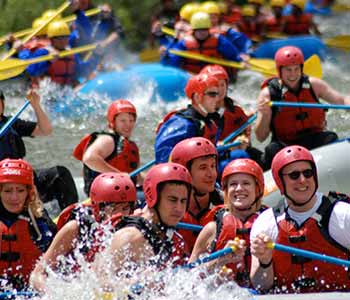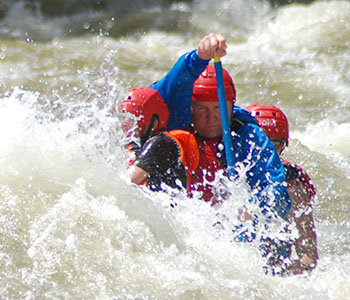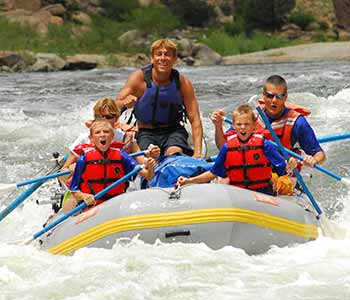What You Need to Know Before You Go
Water Levels
The following Water Level Classifications are meant to be a general guideline only. Although not always a good predictor of the amount of Thrills and Risks you will have on your raft trip, these guidelines do give an indication of what you might encounter on your rafting adventure.

CLEAR CREEK
http://waterdata.usgs.gov/CO/nwis/uv?06716500
Geo commonly refers to the River Gauge at Lawson, CO.
120cfs and Below – Marginal
120 cfs to 350 cfs – Low Water
350 cfs to 650 cfs – Moderate Water
650 cfs and Above – High Water
ARKANSAS RIVER
http://www.dwr.state.co.us/SurfaceWater/data/detail_graph.aspx?ID=ARKWELCO&MTYPE=DISCHRG
Geo commonly refers to the River Gauge at Wellsville, CO.
700cfs and Below – Marginal
700 cfs to 1500 cfs – Low Water
1500 cfs to 3000 cfs – Moderate Water
3000 cfs and Above – High Water
UPPER COLORADO RIVER
http://waterdata.usgs.gov/CO/nwis/uv?09058000
Geo commonly refers to the River Gauge at Kremmling, CO.
500 cfs and Below – Marginal
500 cfs to 1500 cfs – Low Water
1500 cfs to 3000 cfs – Moderate Water
3000 cfs and Above – High Water
Rapid Classifications
The following Rapid Classifications are meant to be a general guideline only. The Classification of a rapid is subjective at best. Factors that may influence the classification of an individual rapid include, but are not limited to: Water Levels, Weather Conditions, and Course Traversed. Click on the class to see a general description.

CLASS I: Rapids
Fast moving water with riffles and small waves. Few obstructions, all obvious and easily missed with little training. Risk to swimmers is slight; self-rescue is easy.
CLASS II RAPIDS: Novice
Straightforward rapids with wide, clear channels which are evident without scouting. Occasional maneuvering may be required, but rocks and medium-sized waves are easily missed by trained paddlers. Swimmers are seldom injured and group assistance, while helpful, is seldom needed. Rapids that are at the upper end of this difficulty range are designated “Class II+”.
CLASS III: Intermediate
Rapids with moderate, irregular waves which may be difficult to avoid and which can swamp an open canoe. Complex maneuvers in fast current and good boat control in tight passages or around ledges are often required; large waves or strainers may be present but are easily avoided. Strong eddies and powerful current effects can be found, particularly on large-volume rivers. Scouting is advisable for inexperienced parties. Injuries while swimming are rare; self-rescue is usually easy but group assistance may be required to avoid long swims. Rapids that are at the lower or upper end of this difficulty range are designated “Class III-” or “Class III+” respectively.
CLASS IV: Advanced
Intense, powerful but predictable rapids requiring precise boat handling in turbulent water. Depending on the character of the river, it may feature large, unavoidable waves and holes or constricted passages demanding fast maneuvers under pressure. Rapids may require “must” moves above dangerous hazards. Scouting may be necessary the first time down. Risk of injury to swimmers is moderate to high, and water conditions may make self-rescue difficult. Group assistance for rescue is often essential but requires practiced skills. Rapids that are at the lower or upper end of this difficulty range are designated “Class IV-” or “Class IV+” respectively.
CLASS V: Expert
Extremely long, obstructed, or very violent rapids which expose a paddler to added risk. Drops may contain large, unavoidable waves and holes or steep, congested chutes with complex, demanding routes. Rapids may continue for long distances between pools, demanding a high level of fitness. What eddies exist may be small, turbulent, or difficult to reach. At the high end of the scale, several of these factors may be combined. Scouting is recommended but may be difficult. Swims are dangerous, and rescue is often difficult even for experts. Proper equipment, extensive experience, and practiced rescue skills are essential.
CLASS VI: Extreme and Exploratory Rapids
These runs have almost never been attempted and often exemplify the extremes of difficulty, unpredictability and danger. The consequences of errors are very severe and rescue may be impossible. For teams of experts only, at favorable water levels, after close personal inspection and taking all precautions.
Age and Size Requirements
Geo places general age requirements on most of its trips. These requirements may vary with Water Level and other factors. Geo Tours reserves the right to impose age and/or size restrictions at Geo’s discretion.
| Rafting Trip | Age Requirement |
|---|---|
Clear Creek | |
| MOUNTAIN LION | 7 years & above |
| OUTER LIMITS | 16 years & above |
| TERMINATOR | 18 years & above |
Arkansas River | |
| BROWN’S CANYON | 10 years & above |
| NARROWS | 16 years & above |
| NUMBERS | 18 years & above |
Upper Colorado River | |
| MOST SECTIONS | 5 years & above |

Physical Requirements
Minimum chest size of a Coast Guard approved Type V PFD is 24”. For persons with less than a 24” chest, the PFD will not fit properly and thus the person may not participate.
Whitewater rafting and related activities requires individual participation. The level of physical activity varies with each trip. With an increasing difficulty level, physical demands and risks proportionally increase. Please consider yours and your group’s needs and abilities when selecting a trip. You may want to consult with a physician prior to taking a trip if you have medical questions or any of the following medical conditions: Allergies (Insect Stings), Asthma, Diabetes, Hearing Impairment, Heart Disease, Osteoporosis, Physical or Psychological Impairment of Swimming, Pregnancy, Seizure Disorders and Vision Impairment. The above list is NOT all-inclusive.
